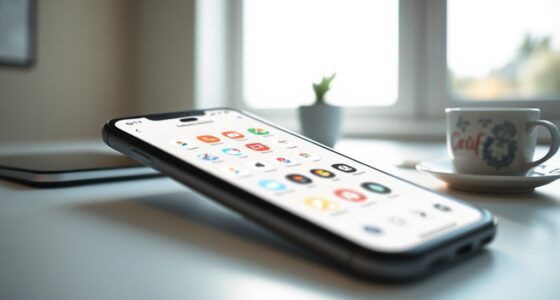Taking quick 30-second micro-breaks can markedly boost your focus and productivity. These short pauses refresh your mind and body, helping prevent mental fatigue and physical stiffness. Simple activities like deep breathing, stretching, or just looking away from your screen can re-energize you and sharpen your concentration. Using technology or adjusting your environment can make these breaks more effective. Keep going to discover how small pauses can lead to big improvements in your work and study performance.
Key Takeaways
- Short 30-second pauses, or micro-breaks, effectively improve focus and productivity during prolonged work or study sessions.
- Mindfulness exercises like deep breathing during breaks reduce stress and enhance mental clarity.
- Physical stretching counteracts muscle tension, boosts circulation, and refreshes the body and mind.
- Incorporating technology and optimized environments support consistent micro-break routines and sustained concentration.
- Regular micro-breaks prevent mental fatigue, improve overall work quality, and maintain high levels of focus over time.

Have you ever felt your focus waning after hours of work or study? It’s a common experience, and it often leads to decreased productivity and frustration. The good news is, you don’t need long breaks to recharge; sometimes, just 30 seconds can do the trick. Micro‑breaks are short pauses designed to refresh your mind and body, and they’re backed by scientific research showing their effectiveness in boosting concentration. By incorporating quick activities like mindfulness exercises or physical stretching into your routine, you can maintain sharp focus throughout your day.
Short breaks of 30 seconds, like stretching or mindful breathing, can significantly boost your focus and productivity.
When you take a micro‑break, consider practicing mindfulness exercises. These are simple, intentional pauses where you direct your attention to the present moment, often through deep breathing or focused awareness. For example, close your eyes for a few seconds and take slow, deliberate breaths, paying attention to how the air feels as it enters and leaves your body. This practice helps reduce mental clutter, stress, and fatigue, allowing you to return to your task with renewed clarity. Mindfulness exercises don’t require much time but can substantially improve your concentration by calming your nervous system and sharpening your focus.
Physical stretching is another crucial component of effective micro‑breaks. Sitting for extended periods can cause muscle tension, reduce circulation, and impair your ability to concentrate. When you pause for just 30 seconds to stretch, you promote blood flow and release built-up stiffness. Simple stretches, like reaching overhead, twisting your torso, or flexing your legs, can invigorate your body and mind. These movements not only reduce physical discomfort but also signal to your brain that it’s time to reset, making it easier to return to your work with a fresh perspective. Incorporating stretching into your micro‑breaks can prevent fatigue and sustain your productivity over longer periods. Additionally, integrating AI tools for real‑time performance tracking can help identify optimal times for these breaks, further enhancing your focus and efficiency. Recognizing the importance of focused attention in productivity, these quick pauses can significantly improve your overall work quality.
Furthermore, understanding the impact of contrast ratio and other technical factors on image quality emphasizes the importance of maintaining optimal conditions for focused tasks. The key is consistency. By intentionally scheduling these brief pauses into your daily routine, you create a rhythm that supports sustained focus. You don’t need to stop working completely; just pause—breathe deeply, stretch, and reset your mental state. To optimize your aura and emotional balance during these moments, incorporating calming visualizations or ambient sounds can be beneficial. Over time, these small interventions accumulate, helping you maintain high levels of concentration and reducing the mental strain that builds during prolonged work sessions. Whether you’re studying, working at a desk, or engaging in creative tasks, micro‑breaks with mindfulness exercises and physical stretching are simple, effective tools to keep your mind sharp and your energy levels steady.
Frequently Asked Questions
Can Micro-Breaks Improve Long-Term Productivity?
You might wonder if micro-breaks can boost your long-term productivity. They help you form a habit of taking short pauses, which aids in cognitive refreshment. Over time, this practice can improve your focus and efficiency, making it easier to sustain high performance. Consistently incorporating micro-breaks supports better mental clarity, ultimately enhancing your overall productivity and helping you maintain peak performance in the long run.
Are Micro-Breaks Effective Across Different Age Groups?
When considering if micro-breaks work across different age groups, you notice how age-related cognitive and generational differences influence their effectiveness. Younger individuals often bounce back quickly, while older adults might benefit more from these brief pauses to refresh focus. You see that micro-breaks can be universally helpful, but tailoring them to individual needs and recognizing these differences enhances concentration and productivity for everyone.
How Do Micro-Breaks Affect Mental Health?
Micro-breaks can considerably improve your mental health by reducing stress and enhancing your mood. When you take short pauses, you give your mind a chance to reset, lowering cortisol levels and preventing burnout. These brief breaks help you feel more relaxed and positive, making it easier to manage daily challenges. Incorporating micro-breaks into your routine supports overall well-being, helping you stay focused and emotionally balanced throughout the day.
What Are the Best Activities to Do During a Micro-Break?
You might wonder what activities best boost focus during a micro-break. Science suggests stretching routines and mindfulness exercises are highly effective. Stretching helps release tension and improves blood flow, while mindfulness keeps your mind present and reduces stress. These quick activities require just 30 seconds, making them perfect for refueling your concentration. Incorporate them into your routine to stay sharp and energized throughout your work or study sessions.
Do Micro-Breaks Work for All Types of Work Environments?
You might wonder if micro-breaks work in all work environments. They can be effective across various settings, especially when combined with ergonomic adjustments to reduce strain. A positive workplace culture that encourages short breaks helps employees stay focused and energized. While some environments might require tailored approaches, adopting micro-breaks generally boosts productivity and well-being, making them a valuable tool regardless of your specific work setting.
Conclusion
In just 30 seconds, taking a micro-break can markedly boost your focus and productivity. Research shows that brief pauses improve concentration by up to 13%, helping you reset and avoid burnout. So, next time you’re feeling stuck or overwhelmed, remember that a quick break isn’t wasting time—it’s a smart move to stay sharp. Incorporate micro-breaks into your routine, and you’ll notice your efficiency and mental clarity improve in no time.










